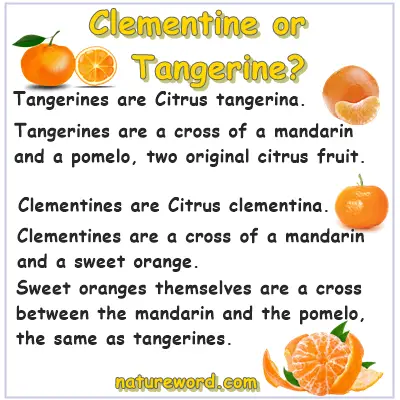Clementine or tangerine? How do you tell apart a clementine and a tangerine? Are clementines the same as tangerines? Is a clementine a tangerine? Is a tangerine a clementine? Are clementines and tangerines oranges? Read on to find out what is the difference between a clementine and a tangerine and what exactly are the two citrus fruit.
How do you tell apart a clementine and a tangerine?
You can tell apart a clementine from a tangerine based on fruit size, fruit shape, more rarely rind color, peel thickness and adherence to the fruit, amount of pith, number, shape and size of segments, taste, degree of acidity and sweetness, juice amount, presence or lack of seeds, and season. However, it does take some experience. Generally, the more research you do on clementines and tangerines, and the more you eat them, the better you’ll get at telling them apart.

But it’s definitely not easy to tell the difference between all the different varieties of orange-like citrus fruit, whether it’s actual oranges, orange hybrids, or citrus fruit that look like oranges but are entirely different types of citrus fruit. There are just so many different types of oranges and orange-like citrus fruit that sometimes not even botanists are clear on which is which unless they have genetic data on them. To make matters worse, the same citrus fruit is often called differently in different parts of the world, or goes by different names within the same region.
Clementine: what is it?
A clementine is a cross between the mandarin, also called mandarine or mandarine orange, and the sweet orange. The scientific name for clementine fruit is Citrus clementina. Colloquially, clementines are also called clementine oranges because of their ancestry (having resulted from mandarins and sweet oranges). The mandarin is an original citrus fruit, but the sweet orange is a cross between the mandarin and another original citrus fruit, the pomelo. There are two major types of clementines: seedless clementines and clementines with seeds.
Also see the benefits of clementines
You might be interested to know : Are Mandarins Acidic or Alkaline?
Tangerine: what is it?
A tangerine is a mandarin orange hybrid. More exactly, tangerines are a cross between a mandarin and a pomelo. Both the mandarin and the pomelo are original citrus fruit. Another cross between the mandarin and the pomelo is the sweet orange, known plainly as the orange. When the mandarin and the sweet orange crossed, they also gave us clementines. Botanically, tangerines are referred to as either Citrus reticulata, the same scientific name used for the mandarin, or as Citrus tangerina, a scientific name that identifies tangerines as an individual species rather than an obscure citrus cross.
The name tangerine refers to not one citrus variety, but several. However, there isn’t a clear consensus on exactly how many tangerine varieties there are since different citrus classification systems propose different numbers. The difference between tangerine varieties is primarily the ratio of mandarin to pomelo, that is, how much mandarin vs pomelo ancestry each of the varieties has. Some tangerine varieties are quite similar genetically speaking, except for characteristics such as resistance to certain diseases.
Also see the benefits of tangerines.

Are tangerines the same as clementines?
Tangerines and clementines are not the same thing. The two citrus fruit are indeed related, but they are entirely different fruit. Tangerines are Citrus tangerina and clementines are Citrus clementina. Tangerines are a natural mutation caused by the accidental crossing of a mandarin and a pomelo, two original citrus fruit. By comparison, clementines are a result of the natural crossing of mandarins and sweet oranges (sweet oranges themselves are a cross between the mandarin and the pomelo, the same as tangerines).
Clementine or tangerine?
- The clementine is a cross of an original citrus fruit (mandarin) and a citrus hybrid (sweet orange) while the tangerine is a cross of two original citrus fruit (mandarin and pomelo).
- Clementines are also called clementine oranges, but are not real oranges. Tangerines are rarely called tangerine oranges, but some mandarin varieties are marketed as tangerines.
- There are different varieties of both clementines (e.g. Corsica clementine, Calabria clementine, Gulf of Taranto clementine) and tangerines (e.g. Moragne, Dancy).
- The clementine is also called a ‘satsuma clementine’, but the clementine (Citrus clementina) and the satsuma (Citrus unshiu) are two different citrus fruit. In fact, the tangerine is more closely related to the satsuma than the clementine is.
- Clementines are generally small fruit, smaller than oranges (about half the size of a typical orange). Tangerines have both medium-sized fruits across all varieties, and small fruits about the same size as clementines.
- Both the clementine and the tangerine look more like mandarin oranges than actual oranges, but the tangerine looks more like a mandarin orange whereas the clementine looks more like an orange.
- Both clementines and tangerines have a deep orange rind, but the clementine has a smooth and glossy skin that is almost shiny, while the tangerine has tiny indentations that give its rind a pebbled appearance.
- Both the clementine and the tangerine have a thin rind that is easy to peel – they are both significantly easier to peel than mandarins and oranges, with clementines being the easiest to peel.
- Clementines have a slightly oblate shape vs tangerines which are somewhat flattened at the poles, with some cultivars looking quite deflated.
- Clementine flesh is very juicy and sweet, slightly acidic, but less acidic versus that of sweet oranges. Tangerine flesh is also very juicy and less acidic than that of sweet oranges, but a lot sweeter. See the benefits of clementine juice.
- Clementines separate into segments easily, with typically 7, 10 or 14 segments per fruit. Tangerines also separate into segments fairly easily, and most varieties have segments with rounded edges.
- Both clementines and tangerines have very little white pith, or albedo (the spongy white tissue between the rind and fruit segments) which is what makes them so easy to peel.
- Versus clementines, tangerines are commonly sold with stems and leaves.
- In terms of nutrition, both clementine and tangerines have about the same nutritional value, with slight differences that can be accounted for by variety, degree of ripening, climate in the region of cultivation, yearly weather conditions and other factors.
- Both clementine and tangerines are safe to eat, but tangerines are safer – clementines have been found to interact with certain medications used for treating high blood pressure, kidney disease, diabetes, blood clots and more.
- Both clementines and tangerines have varieties with seeds, with very few seeds or underdeveloped seeds, or with no seeds, but of the two, clementines are better known for their seedless fruit.
- Both citrus fruit have roughly the same season, and are available late fall through winter, often also well into spring.
- The clementine is great for eating raw and yields good amounts of orange-like juice, vs the tangerine which is great for eating raw, juicing and has a highly aromatic rind for uses such as flavoring foods and baked goods.
